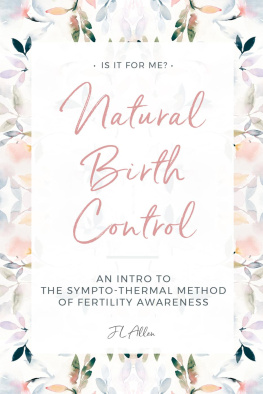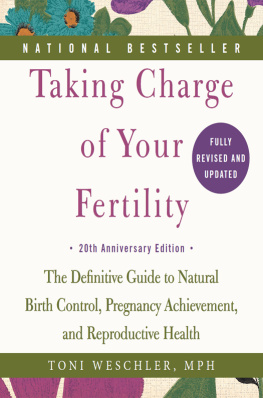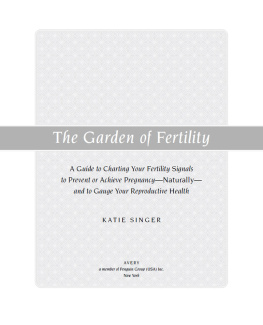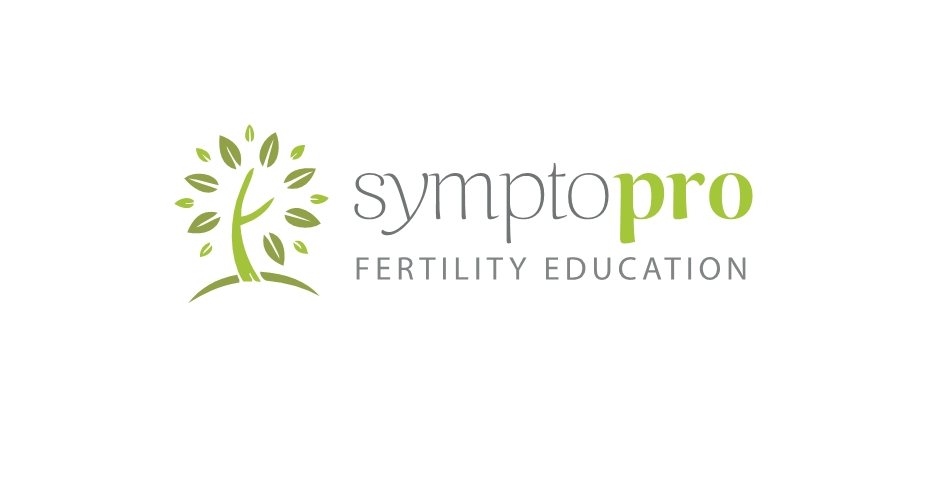Forward
In the fall of 2000, as a first-year resident at Lancaster General Hospitals Family Medicine Residency Program in Pennsylvania, an encounter with a physician colleague transformed my perspective on womens health and family planning. I was on the maternity floor, writing prescriptions for birth control for my postpartum patients. As we discussed the effectiveness rates of various methods and the myriad of side effects associated with them, my senior resident, Dr. Pearl Huang, said, Do you know there are family planning methods that have no medical side effects and can be used effectively to both avoid and achieve pregnancy? I stared at her in disbelief.
"Every form of birth control has side effects, I said, maybe only mild ones, like mood changes or breakthrough bleeding, but sometimes more severe ones, like blood clots, too.
Thats not true, she informed me. "Natural methods of family planning work by teaching women to track the signs of their fertility and do not disrupt a womans normal physiology or cause adverse side effects. I was stunned! Even though I was already a physician, like most medical professionals and most young women, I had never heard about these methods.
Natural or fertility awareness based methods (FABMs) are true forms of family planning that couples can use whether they seek to avoid or hope to achieve pregnancy. Additionally, learning how to chart her cycles enables a woman to understand and monitor her reproductive and overall health. This is truly empowering, as she is able to understand her fertility and plan her family without suppressing or disrupting her normal, natural cycles.
A womans chart is a visible sign of the cyclic hormonal activity in her body. As her hormones fluctuate during a given cycle, they produce observable external physical signs, such as cervical fluid changes, that a woman can record to understand and track her unique cycle. A womans chart is a window through which she can see how her hormones impact her reproductive organs. As such, the chart of the female cycle serves as a fifth vital sign that a woman can use to monitor her health and manage symptoms that may be associated with her cycle.
For example, if a woman experiences irregular cycles, painful periods, abnormal bleeding, inability to conceive, or other gynecologic concerns, charting allows her to record important information about her reproductive health. This valuable history may provide key data to help medical professionals trained in FABMs to diagnose specific health problems and assist in treating these conditions.
Charting is especially beneficial in helping adolescents understand the changes in their bodies during puberty. A young girl can learn to recognize what is normal and healthy as it relates to her cycle, cervical fluid, and menses. Adolescents often experience irregular cycles during their first few years of menstruation and may not know that there is such a thing as normal secretions. By charting, a young woman learns to understand her body, predict the onset of her menstruation, and thereby reduce unnecessary concern and anxiety.
As a physician now trained in FABMs, I feel fortunate that I can educate women about their normal cyclical signs and empower them to understand and appreciate their reproductive health. As Executive Director of FACTS ( www.FACTSaboutFertility.org ), I am delighted to partner with SymptoPro to train future health care professionals to teach women how to chart their cycles! Once educated, girls wont need to ask for the birth control pill to regulate their cycles, and they will recognize that their recurrent egg-white vaginal discharge is likely their normal cervical fluid secretions produced under the influence of estrogena healthy sign of fertility.
When women chart their cycles, we can work together to identify any underlying abnormalities and then treat the root cause. As I teach my medical students, it is critical to listen to the people we care for, as they can provide the most important information that enables us to help them. So, please, do chart about YOU! ~ Dr. Marguerite Duane, MD, MHA, FAAFP
All rights reserved. No part of this publication may be reproduced or transmitted in any form or by any means electronic or mechanical, including photography, recording, or any information storage and retrieval system now known or to be invented, without written permission from the publisher.
RFuller, 2017
ISBN #1-880220-00-8
Printed in the U.S.A.
Northwest Family Services
6200 SE King Road, Portland, Oregon 97222
Telephone: (503) 546-6377, FAX (503) 546-9397
website: www.symptopro.org
email:
Online NFP instruction is available at www.symptopro.org
Learner Assignments: Avoiding Pregnancy
A Note to the Reader:
This manual provides essential background in the basics needed to observe and chart naturally occurring signs of fertility. It is recommended that before applying the information to your own situation you work in conjunction with a certified SymptoPro Instructor competent in the Sympto-Thermal Method of NFP.
- Participate in all classes, on time, as a couple (if possible), and check your understanding by successfully doing the learning activities.
- Submit copies of your charts to your SymptoPro Instructor for the first six cycles, and show you know how to apply the guidelines to them. Start charting right away.
After Session One:
Read Introduction and : waking temperature, tissue paper exam, vaginal sensations, and Peak Day. Use the Beginner Chart (with instructions) to chart temperature and tissue.
After Session Two:
Read about : Living With NFP. Think about it; talk about it. Read the handouts provided in class.
After Session Three:
Read all of Chapter Three, especially about : Common Questions. For the next six months, send in your chart at the end of each cycle.
Note: All Charts found in this text are identified by a number in the upper left-hand corner of each chart.








